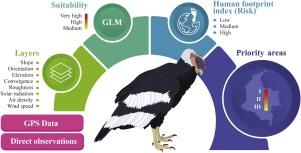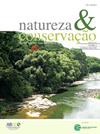Identifying priority conservation areas for the Andean Condor in Colombia
IF 3.5
2区 环境科学与生态学
Q1 BIODIVERSITY CONSERVATION
引用次数: 0
Abstract
The Andean Condor (Vultur gryphus) is a globally threatened species. Its highly mobile capability presents important challenges for conservation planning, especially in extremely geographically complex regions such as Colombia, where little is known about its ecology. Over the past three decades, financial and technical conservation efforts have primarily focussed on reintroduction and local management strategies. However, these initiatives did not properly prioritize the various conservation measures undertaken. We utilized roosting locations across Colombia to identify suitable roosting distribution with high risk because of the anthropogenic impact on a Systematic Planning Tool for decision-making based on robust spatial habitat modelling to define where and how should focus the Andean condor conservation actions in the country. Specifically, we aimed to develop a conservation planning tool to facilitate spatially explicit decision-making. Our results showed that Colombia has at least 19,571.33 km2 of suitable roosting habitat for this species, but over 30% of this area is currently considered to be under conservation risk due to severe anthropogenic impacts. Considering this, we suggested different actions for each proposed area according to potential threats generated by human communities.

确定哥伦比亚安第斯秃鹰的优先保护区
安第斯秃鹰(Vultur gryphus)是全球濒危物种。它的高度流动性给保护规划带来了重大挑战,尤其是在哥伦比亚等地理环境极其复杂的地区,人们对其生态知之甚少。在过去的三十年里,资金和技术方面的保护工作主要集中在重新引入和当地管理策略上。然而,这些措施并没有对各种保护措施进行适当的优先排序。我们利用哥伦比亚各地的栖息地,确定了受人类活动影响风险较高的合适栖息地分布,并基于强大的空间栖息地建模,开发了用于决策的系统规划工具,以确定安第斯秃鹰保护行动的重点和方式。具体来说,我们旨在开发一种保护规划工具,以促进空间明确的决策。我们的研究结果表明,哥伦比亚至少有 19571.33 平方公里适合该物种栖息的栖息地,但由于严重的人为影响,其中超过 30% 的区域目前被认为面临保护风险。有鉴于此,我们根据人类社区造成的潜在威胁,为每个拟议区域提出了不同的行动建议。
本文章由计算机程序翻译,如有差异,请以英文原文为准。
求助全文
约1分钟内获得全文
求助全文
来源期刊

Perspectives in Ecology and Conservation
Environmental Science-Nature and Landscape Conservation
CiteScore
7.80
自引率
4.30%
发文量
46
审稿时长
59 days
期刊介绍:
Perspectives in Ecology and Conservation (PECON) is a scientific journal devoted to improving theoretical and conceptual aspects of conservation science. It has the main purpose of communicating new research and advances to different actors of society, including researchers, conservationists, practitioners, and policymakers. Perspectives in Ecology and Conservation publishes original papers on biodiversity conservation and restoration, on the main drivers affecting native ecosystems, and on nature’s benefits to people and human wellbeing. This scope includes studies on biodiversity patterns, the effects of habitat loss, fragmentation, biological invasion and climate change on biodiversity, conservation genetics, spatial conservation planning, ecosystem management, ecosystem services, sustainability and resilience of socio-ecological systems, conservation policy, among others.
 求助内容:
求助内容: 应助结果提醒方式:
应助结果提醒方式:


